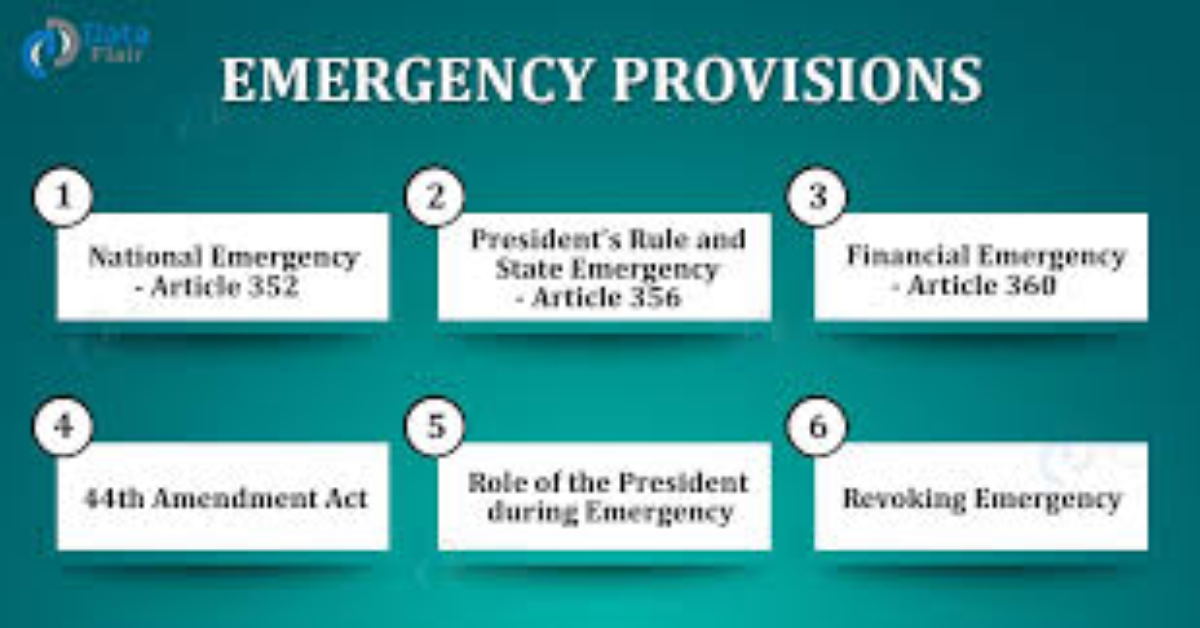The Indian Constitution provides a framework for emergencies to ensure national security, governance stability, and economic control in times of crisis. The Emergency Provisions (Articles 352–360) grant extraordinary powers to the Central Government, allowing it to override the normal distribution of powers between the Centre and the States.
While these provisions help maintain order during crises, they also pose risks of abuse and suppression of civil liberties. In this blog, we will explore:
- Types of Emergencies under the Indian Constitution
- Powers granted during an Emergency
- Legal and Constitutional Implications
- Judicial Safeguards against misuse
1. Constitutional Basis for Emergency Provisions
The Emergency Provisions are contained in Part XVIII (Articles 352 to 360) of the Indian Constitution. These provisions empower the President of India to take extraordinary measures when the nation faces:
- External threats or internal disturbances
- Breakdown of constitutional machinery in states
- Financial instability
These provisions were inspired by Britain’s emergency powers and the Weimar Constitution of Germany, but India’s experience has shown both their necessity and potential for misuse.
2. Types of Emergencies in the Indian Constitution
There are three types of Emergencies in India:
| Type of Emergency | Article | Reason | Declared By | Approval Requirement |
|---|---|---|---|---|
| National Emergency | Article 352 | War, external aggression, or armed rebellion | President | Parliament (within 1 month) |
| State Emergency (President’s Rule) | Article 356 | Failure of constitutional machinery in a state | President | Parliament (within 2 months) |
| Financial Emergency | Article 360 | Financial instability threatening India’s sovereignty | President | Parliament (within 2 months) |
3. National Emergency (Article 352)
When is it declared?
- If India’s security is threatened due to war, external aggression, or armed rebellion.
- Example: 1962 (China war), 1971 (India-Pakistan war), and 1975 (Internal Emergency under Indira Gandhi).
Effects of National Emergency:
- Fundamental Rights get restricted
- Article 19 (Freedom of Speech, Expression, Assembly, etc.) is suspended.
- Right to Life under Article 21 remains enforceable (K.S. Puttaswamy Case, 2017).
- Centre gets more power over states
- Parliament can make laws on State List subjects.
- The term of Lok Sabha and State Assemblies can be extended beyond 5 years.
- Economic control by the Centre
- Government can control financial and property resources.
Judicial Safeguards:
- 44th Constitutional Amendment (1978) introduced safeguards:
- Internal disturbances was replaced with armed rebellion.
- President needs a written recommendation from the Cabinet before declaring an emergency.
Misuse of National Emergency:
- The 1975 Emergency declared by Indira Gandhi was heavily criticized for suspending civil liberties, jailing opposition leaders, and imposing press censorship.
4. State Emergency (President’s Rule) – Article 356
When is it declared?
- If a state fails to follow the Constitution or its government collapses.
- Example: Political instability, breakdown of law and order, refusal to comply with the Centre.
- Used over 125 times in India!
Effects of President’s Rule:
- State government is dismissed
- The Governor administers the state on behalf of the President.
- The State Assembly can be dissolved or suspended.
- Parliament makes laws for the state
- State’s legislative powers shift to Parliament.
Judicial Safeguards:
- S.R. Bommai vs. Union of India (1994):
- President’s Rule is subject to judicial review.
- The Supreme Court ruled that misuse of Article 356 is unconstitutional.
Misuse of Article 356:
- Used excessively to dismiss opposition-ruled state governments (e.g., Kerala (1959), Karnataka (1989)).
- The Sarkaria Commission (1988) recommended that it be used only as a last resort.
5. Financial Emergency (Article 360)
When is it declared?
- If India’s financial stability is threatened (e.g., economic crisis, government bankruptcy).
Effects of Financial Emergency:
- Centre controls state financial decisions
- The President can reduce salaries of government employees and judges.
- The Centre can direct financial policies of states.
- Economic measures imposed
- The government can control money supply and resource allocation.
Judicial Safeguards:
- Financial Emergency has never been declared in India.
- No time limit is mentioned in the Constitution, which means it can continue indefinitely once imposed.
6. Legal Implications and Concerns
1. Threat to Fundamental Rights
- During a National Emergency, civil liberties are suspended.
- Press freedom and political dissent are restricted, as seen during the 1975 Emergency.
2. Concentration of Power in the Executive
- Emergency provisions increase the power of the Central Government, reducing state autonomy.
- In many cases, Article 356 has been misused for political gains.
3. Lack of Parliamentary and Judicial Oversight
- The Financial Emergency provision does not have adequate judicial safeguards.
- President’s Rule (Article 356) was frequently used before the S.R. Bommai judgment limited its misuse.
4. Judicial Review and Safeguards
- The Supreme Court has ruled that Emergency Provisions cannot be misused (e.g., S.R. Bommai Case, Kesavananda Bharati Case).
- The 44th Amendment (1978) provided some safeguards but still does not fully prevent executive overreach.
7. Conclusion: Balancing Power and Accountability
Emergency provisions are necessary to maintain national security, governance stability, and financial control. However, history shows that they can be misused for political purposes.
Reforms Needed:
- Stronger judicial oversight to prevent misuse.
- Clearer financial emergency provisions with accountability mechanisms.
- Increased parliamentary control to ensure democratic balance.
- Public awareness of fundamental rights, even during an emergency.
The right balance between executive power and constitutional safeguards is crucial to ensure that Emergency Provisions are used only in genuine national crises and not as a tool for political dominance.

